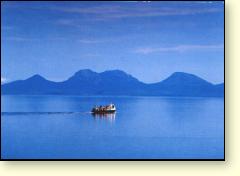


Isle of Jura
Jura has long been a sparsely inhabited island. When local estate-owners commissioned the reconstruction of the old distillery at Craighouse in the early 1960s to try and revive the community, the 250-strong workforce brought in more than doubled the island’s population. A single highway, the Long Road, runs round the southern and eastern sides of Jura and peters out towards the northernmost point, just past where novelist George Orwell wrote 1984. The west coast is uninhabited. The island is not inhospitable, just undeveloped. Over 5,000 deer roam, mainly in the north, and gave the island its name (Jura derives from the Norse for ‘Deer Island’). A long time ago there were also wild boar and the occasional wolf.
Half a dozen crofts are worked on Jura today but in the past there were many more – and cottars too. The latter had no land-entitlement, working for the laird and living in a tied cottage. Cottars had to do stipulated duty-work without payment and if they did not maintain their houses well enough – including new thatch to the roofs every second year – they had to reimburse the laird for the fall in their value. If a cottar was visited by friends or family, two shillings per day had to be paid to the laird – the equivalent of a day’s work. They even had to keep their pigs locked up until the potato crop was dug and their chickens cooped up during seeding and harvest time.
Jura seems to have escaped the abuses of the infamous Highland Clearances when tenants on estates were evicted to make way for sheep grazing. Many families did, however, surrender to the lure of emigration to try for a better life in the colonies. Jura was part of the drovers’ route to mainland cattle trysts and the drove roads ran across the south of the island from the ferry at Feolin to Lagg on the east coast.
The conventions of Highland hospitality required that travellers be taken in, fed and given shelter for the night. However, this often caused hardship for many country-dwellers who were extremely poor, so change-houses – wayside inns – were introduced to remove the burden. The Long Road had four or five change-houses.
Jura is part of the Highland category of malt whiskies although recent attempts to lend greater precision to classifying styles place it in an Island sub-group.
Above: The Paps of Jura with the car ferry from Kintyre to Islay in the foreground.
Isle of Jura Distillery
Oban Distillery
Moving on
After Jura distillery, the trail may be continued either by ferry via the island of Colonsay to Oban, or by returning to Kennacraig. Between here and Oban, where the next distillery is located, of interest are:
• At Inveraray, the actual 19th-century jail and courthouse have live ‘warders’ and ‘prisoners’ as guides. Talk to them, visit the furnished cells, and sit in on the trials. Behave yourself, though, or you may be locked into one of the exercise cages!
• Inveraray Castle, splendid home of the Duke of Argyll, chief of the Clan Campbell, who has his own brand of whisky. Inveraray was the base where seaborne landing techniques evolved. Robert Adam was involved in redesigning the beautiful lochside town when it was moved from its old location in the 18th century.
• Poltalloch is a widely scattered prehistoric complex featuring an extraordinary concentration of neolithic chambered tombs, stone circles, standing stones and inscribed rocks near Kilmartin. Dunadd was an important Dark Age hill-fort.
• Carnasserie and Kilchurn castle ruins are substantial and in beautiful settings. Carnasserie is a fine 16th-century tower house burned in clan warfare; its staircase and wall-walk are still intact. Kilchurn has an overwhelmingly romantic setting on a peninsula on Loch Awe with a great sweep of mountains all around.
• The old Iron Furnace at Bonawe was set up nearly 250 years ago and is the most complete remaining charcoal-fired ironworks in Britain.